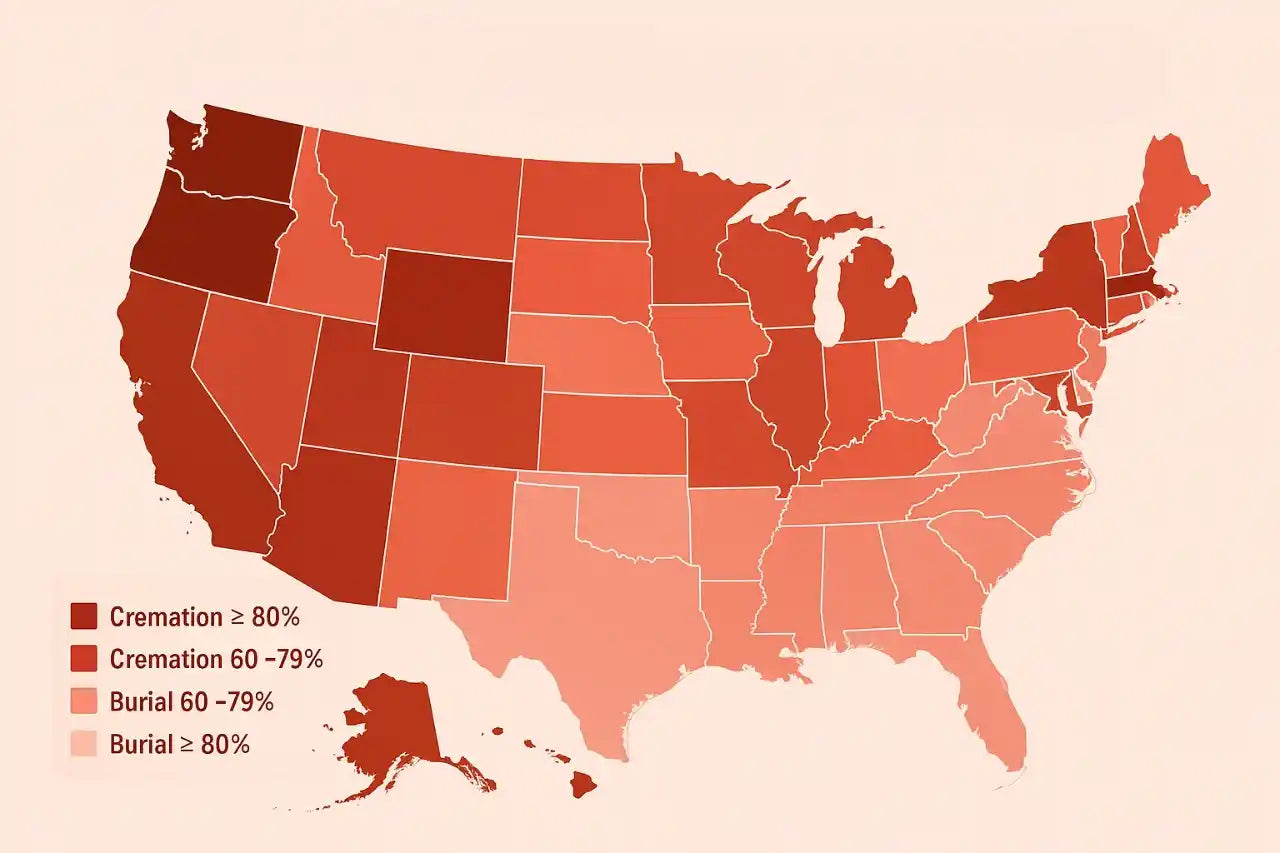Picking a headstone can feel overwhelming. You want it to be just right, and there are so many choices. Don't worry, we'll go through it together.
Every headstone is unique. Some are tall and catch the sunlight, while others are flat and simple with meaningful words. Your choice will create lasting memories, so it's important to take your time.
You might not realize there are many styles beyond the traditional upright stone. There are modern designs and classic shapes, each honoring memories in different ways. Some people prefer headstones that stand out, while others like something more understated.
Let's explore your options together. No complicated terms or pressure, just clear information to help you choose a memorial that honors your loved one.

The Importance of Style Selection
Choosing a headstone is more than just picking a shape. It's about honoring your loved one's life in a meaningful way.
Think about who they were. Were they energetic and lively? A tall, eye-catching monument might suit them. Maybe they were quiet and graceful. A simple, elegant marker could be the best fit.
But it's not only about their personality. There are practical things to consider too. Some cemeteries have rules about the size and type of headstones you can use. It's a good idea to check these guidelines before deciding on a style you like.
Weather is another factor. If you live in an area with extreme winters or hot summers, certain materials and designs will last longer and look better over time.
And of course, budget is important. Headstones come in various price ranges. You can find something beautiful that honors your loved one without spending too much.
The right style should balance personal meaning, practical requirements, and your budget. It's about finding the perfect combination that works for your family and honors your loved one's memory.

Traditional Upright Monuments
When most people think of headstones, the traditional upright monument usually comes to mind. These are the classic stones that stand tall and proud, often reaching heights of 3 to 5 feet. Picture those timeless memorials you've seen in historic cemeteries - that's what we're talking about.
These monuments pack a visual punch. They give you plenty of space to work with - front, back, and sometimes even the sides can tell your loved one's story. You can add longer inscriptions, dates, meaningful symbols, or even photographs. Many families choose to include favorite quotes, religious verses, or detailed artwork.
The best part about upright monuments? They're built to last. Most are crafted from high-grade granite, which stands strong against decades of weather. You can pick from colors like Bahama Blue, Dakota Mahogany, or traditional Gray, each bringing its own character to the memorial.
But here's what you should know: they do need more planning. They're usually the priciest option, and not every cemetery allows them. You'll need a solid foundation, and installation takes more work. Some cemeteries have height limits or specific sections for upright monuments.
Perfect for: Family plots, couples who want a shared memorial, or when you want to make a lasting statement that can be seen from anywhere in the cemetery.

Slant Markers
Think of slant markers as the perfect middle ground in headstone design. They rise from the ground at a 30-degree angle, making them easier to read than flat markers but more subtle than upright monuments.
Picture a wedge-shaped stone that's typically about 16 inches high at the back and slopes down to about 6 inches in the front. This clever design lets rainwater run off easily, which means less cleaning for you. Plus, that angled face catches the light beautifully, making inscriptions and designs pop.
Cost-wise, you're looking at a friendlier price tag than upright monuments. They use less material but still give you plenty of space for inscriptions, dates, and artwork. Many families love them because they're noticeable without being overwhelming.
Here's a practical bonus: most cemeteries welcome slant markers. They're stable, don't need as much foundation work as larger monuments, and maintain a clean, uniform look across the grounds.
They're particularly great if you want something that stands out more than a flat marker but doesn't dominate the landscape, kind of like finding that perfect balance between presence and subtlety.

Flat Markers
Flat markers keep things simple and elegant. They sit flush with the ground, creating a clean, level surface across the cemetery. Think of them as a seamless part of the landscape - peaceful and understated.
These markers typically measure around 24" x 12" for singles and 36" x 12" for companions. Despite their modest size, you'd be surprised at what we can fit on them. Names, dates, meaningful symbols, even small designs all work beautifully on a flat marker. Some families add a small vase for flowers, giving the space a personal touch.
The big plus? They're usually the most budget-friendly option. They're also super practical - lawn mowers can pass right over them, and most cemeteries love them because they make maintenance easier. No worries about stones tipping over during harsh weather either.
Just keep in mind that you'll need to brush off leaves and dirt now and then. Some families grab a photo of the spot on their first visit - flat markers can be tricky to find in winter when snow covers the ground.
Perfect for: Modern memorial parks, military sections, and anyone wanting a clean, minimal look.

Pillow Markers
Pillow markers offer a gentle rise from the ground - imagine a thick book resting open on a table. They sit higher than flat markers but lower than slant designs, usually about 6 to 8 inches at their highest point.
The slightly raised design means you won't have to bend down as far to read the inscription, and they're less likely to get hidden by grass clippings or leaves. Rain and snow tend to slide right off, keeping the surface cleaner naturally. Nice, right?
Size-wise, they typically run 24" x 12" for individuals and 36" x 12" for companions. You get plenty of space for names, dates, and designs on that gently sloped face. Many families love adding small designs or symbols. They show up beautifully on that angled surface.
Price-wise, pillow markers hit a sweet spot. They cost more than flat markers but less than upright monuments. Most cemeteries welcome them too - they're stable, look neat, and don't interfere with groundskeeping.

Special and Custom Designs
Want something unique? Let's talk about custom designs. These are the headstones that make people stop and look twice - in a good way.
Some families add sculpted elements like angels, hearts, or crosses that rise from the stone. Others go for custom shapes: we've created everything from guitar-shaped markers to ones that look like open books. One family even requested a design that included their dad's favorite fishing boat.
Photo etchings are popular too. We can engrave a detailed portrait or favorite photo right into the stone. Think landscape scenes, hobby items, or meaningful symbols. The possibilities are pretty amazing.
Just keep two things in mind. First, custom work usually costs more - that's just the nature of unique designs. Second, you'll need cemetery approval. Some places have strict rules about custom pieces.
But when will it work out? These memorials become conversation pieces that tell rich, personal stories. They're more than markers, they're pieces of art that capture someone's life in stone.
These markers work great when you want something more visible than a flat marker without going to a full upright monument. They're modern, practical, and just right for many families.
Making Your Decision
Take your time with this choice, there's no need to rush. Here's what to think about:
First, check your cemetery's rules. Some have strict guidelines about sizes and styles. A quick call to them can save you headaches later.
Think about your budget range. Remember, a beautiful tribute doesn't have to drain your savings. Each style we've discussed comes in different price points.
Consider maintenance too. Will someone visit often to clean the stone? Flat markers need more frequent cleaning, while upright monuments are easier to keep tidy.
Most importantly, trust your gut. Which style feels right for your loved one? Which one makes you smile when you picture it? Sometimes the perfect choice isn't the fanciest or most expensive, it's the one that feels true to the person you're honoring.
Need help deciding? We're here to walk you through options and answer questions.
Conclusion
Choosing a headstone style is a personal journey, and every family's choice will be different. Whether you're drawn to the classic dignity of an upright monument or the subtle grace of a flat marker, what matters is that it feels right for your loved one.
We're here to help turn your choice into reality. At Signature Headstones, we've helped thousands of families create lasting memorials that tell their unique stories. Visit our store to explore our full collection of styles, or reach out if you'd like to discuss your ideas. Our design team is ready to help you create a memorial that perfectly honors your loved one's memory.
Remember, there's no rush - take the time you need to make this important decision. Your loved one's memory deserves a thoughtful choice that will stand the test of time.


